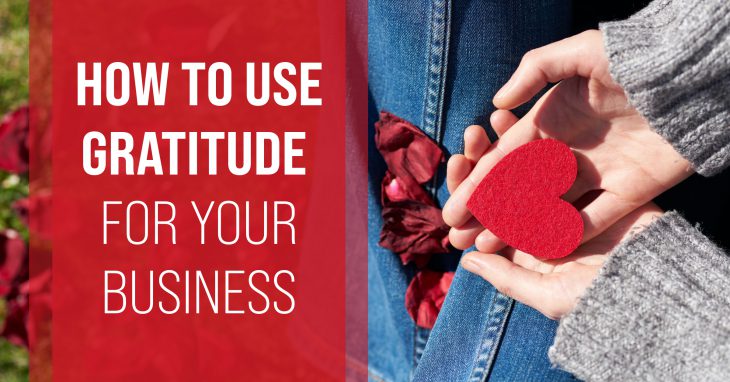Think about your favorite brand. Why are they your favorite? Does it remind you of when you were a kid? Do they have outstanding customer service? Does it give you some other positive feeling? The chances are your favorite brand earned that title because it gives you a positive feeling when you think about it. Interestingly, one way to build relationships with customers is by creating an emotion that is associated with your brand. There are a lot of different ways to do this. As an emotion researcher my favorite way to create this association is through positive emotions.
Specifically, today we are going to talk about the positive emotion of gratitude. There have been many academic papers published about the importance of gratitude in building relationships with customers. However, there is very little accessible information for managers and business owners for how to practically apply this information. In this article we will first talk about why emotions are an important part of marketing. Next we will cover what gratitude is and discuss why gratitude is important for relationship building. Finally, I will end with a few tips on how to use gratitude for your business.
Why Emotions?
Some people might wonder why using emotions is an effective way to build your brand. Emotional appeals have been utilized in marketing for many years. In fact, there is evidence to show that individuals often use emotions in their decision-making processes. There have been papers which show that certain positive emotions can make a person more patient, compassionate and likely to engage in prosocial behavior (Bartlett & DeSteno 2006, DeSteno, 2009, DeSteno, Condon & Dickens 2016). One paper in particular said that when people feeling nostalgic were asked to choose between a smaller payout now or a larger payout later, were waiting for a table at a restaurant and were ordering a package online, they were more patient in all cases (Huang, Huang, & Wyer, 2016).
Emotions Change Decision Making
Additionally, Lerner, Li, and Weber (2013) found that sadness can make people impatient even when decisions are linked to real financial choices. This tells us that that sadness can make individuals less patient. It is thought that this developed as a way for people to avoid loss (Lerner et al., 2013; Lerner, Small, & Loewenstein, 2004). In other studies we can see sadness and anger effecting thought processes in different ways. Sad, and angry participants had a harder time problem solving compared with happy and no emotion participants (Knapp, & Clark, 1991). These, along with numerous other examples, show us that emotions influence behavior in real and measurable ways (DeSteno, Li, Dickens, & Lerner, 2014; DeSteno, Duong, Lim, & Kates, 2019; DeSteno, Bartlett, Baumann, Williams, & Dickens, 2010; Keltner, Haidt & Shiota, 2006, Smith, Pederson, Forster, McCullough, & Lieberman, 2017).
Emotions have a Purpose?
Based on the studies that I mentioned earlier and plenty of others, some researchers argue that emotions have evolved with a purpose. That purpose is to guide thoughts and behaviors toward the best possible outcome as quickly as possible. (Keltner et al. 2006). Meaning that emotions can change the way that people make decisions. It is also thought that specific emotions are supposed to solve specific problems (DeSteno, 2009). What does this mean? Well emotions like anger are thought to lead people to action. Specifically it causes people to move to correct injustices. Another example is disgust. Disgust is thought to protect us from things that might be harmful. There had been a lot of research on emotions which is how we can point to the idea that some might have specific purposes.
What Emotion to Use?
In the last section I told you that emotions are an important part of decision
making. I also told you that specific emotions are supposed to help us to do certain things. So how do you know what emotion to associate with your brand in order to build lasting relationships with your customers? There are a variety of emotions that you could choose from. The good news is that a lot of emotions can be used to build relationships with customers. For this particular blog article the emotion that I recommend is gratitude.
Why Gratitude
Gratitude is a relatively easy emotion to express and it serves a variety of functions all of which lead to better social relationships. Gratitude can help to identify, motivate, and reinforce moral actions (McCullough, Kilpatrick, Emmons, & Larson, 2001). What does that mean for you? Basically, gratitude not only feels good but also promotes behaviors which are good for your relationships.
Another fun fact is that persons who experience gratitude tend to provide prosocial actions not only to those who have been helpful to them but also to unrelated third parties (Bartlett, & DeSteno, 2006, Trivers, 1971). So by being grateful you are making someone else feel better. You are also making it more likely for them to go out and do something kind. You are making the world a better place. Finally, gratitude makes people feel good. When you express gratitude to someone you are making them more likely to do the same action in the future (McCullough, et al. 2001).
Another fun side effect of gratitude is that it makes you feel like you have better relationships. People who regularly experience gratitude feel more loved and cared for by others. Because they feel more loved they actually have better relationships (McCullough, et al. 2001). Gratitude does a lot of positive things. One of the biggest being that it builds and strengthens social bonds and friendships (Algoe, 2012, Emmons & Shelton, 2002).
Managerial Recommendations

Photo by Simon Maage on Unsplash
What does all of this mean for managers? The answer is actually relatively simple. You should be expressing gratitude to your customers when given the opportunity. Thank them for their loyalty. Tell them thank you for your purchase. Thank your customers often. By doing this you will be working to strengthen the bond that they feel with your company. When you thank your customers they will feel valued and appreciated. They will also be more likely to do whatever you thanked them for again in the future. By leaving your customers feeling good you are creating customers for life. So go out there and build lasting relationships with your customers. And thanks for reading!




